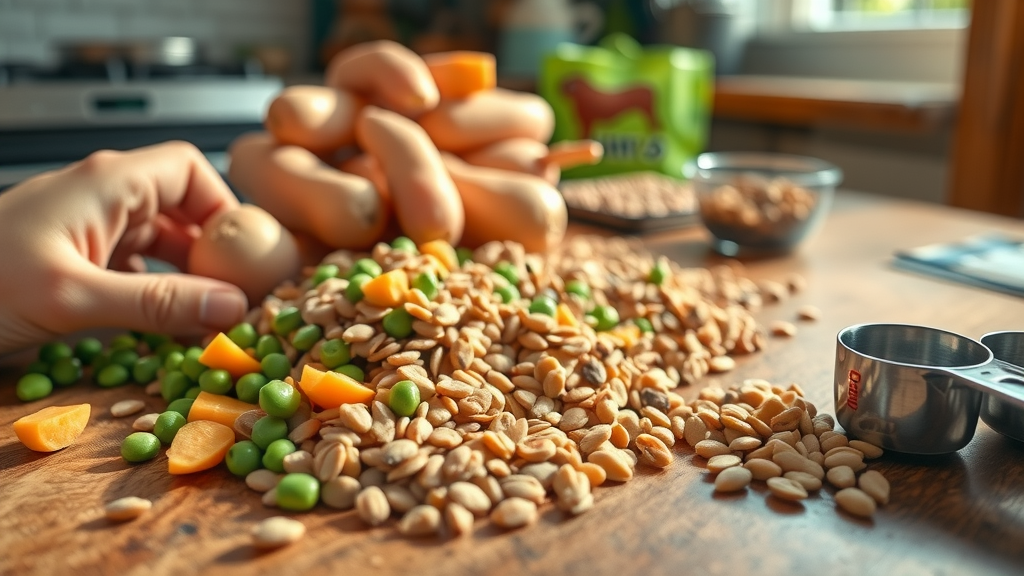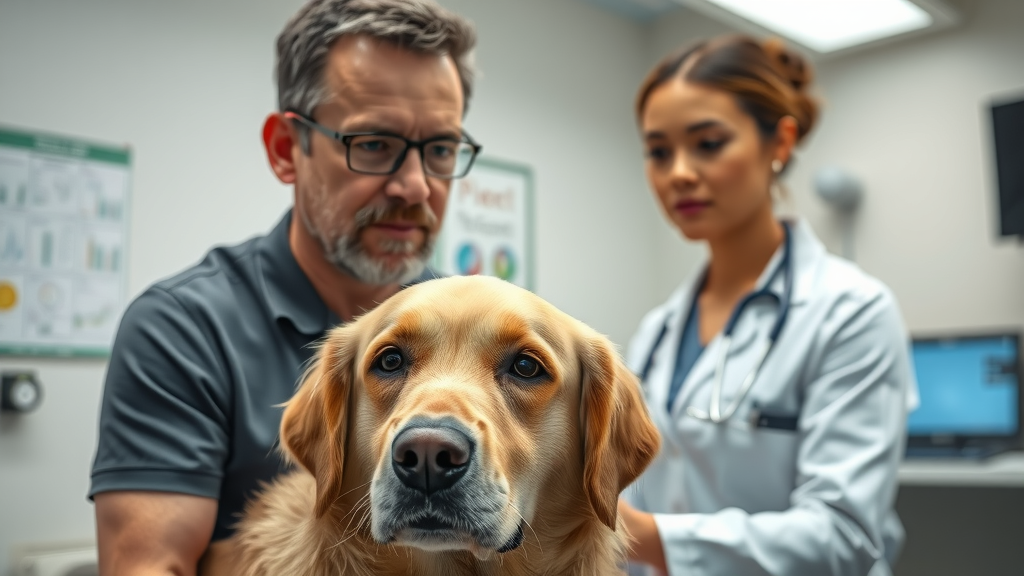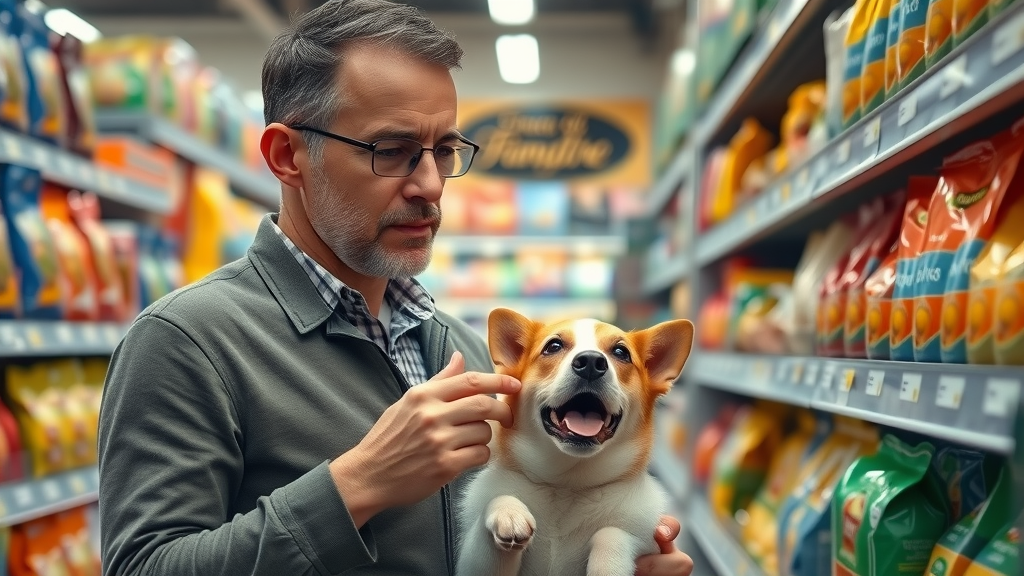Did you know that reports submitted to the FDA have identified hundreds of cases of canine heart disease potentially linked to grain-free dog food in just the last few years? As headlines swirl and pet store aisles overflow with “free dog food” options, today’s concerned pet owner faces a complex—and hotly debated—decision about what ends up in their dog’s bowl. This article dives into the real science, industry practices, and expert perspectives shaping the grain-free dog food movement. If you want clear answers on whether going grain-free will help (or harm) your canine companion, read on.

Is Grain-Free Dog Food the Solution or a Passing Fad? A Data-Driven Take
The grain-free dog food trend has exploded, with pet owners nationwide swapping traditional kibbles for recipes focused on ingredients like sweet potato, lentils, and legumes. On the surface, these “free dog food” products promise reduced allergens, shinier coats, and the allure of a diet closer to what wild canines might consume. But beneath the marketing campaigns lurk urgent questions: Is a grain-free diet simply a passing fad, or is it truly a transformative solution for your dog’s health? The U.S. Food and Drug Administration (FDA) began investigating a surge in dilated cardiomyopathy (DCM) in dogs, a potentially fatal condition, as early as 2018. Some studies suggest a possible connection between grain-free dog foods, taurine deficiency, and the rise in DCM cases—especially among golden retrievers and other specific breeds.
While such findings have ignited passionate debates among pet parents and veterinary professionals alike, the full picture is much more nuanced. Grain-free dog food can benefit dogs with legitimate food allergies or digestive sensitivities, but owners must navigate a sea of marketing hype and incomplete science. Later, we’ll explore amino acid profiles, veterinary nutritional statistics, and the real risks and rewards for your beloved pet. Before deciding, examine all sides—myths and realities alike—to ensure your dog’s food is both safe and nutritionally sound.
- The controversial relationship between grain-free dog food and canine heart disease
- Scientific findings on taurine deficiency and DCM cases
- Tips for pet owners navigating food allergies and special diets
- Veterinary perspectives and nutritional statistics
Understanding Grain-Free Dog Food: Ingredients, Marketing, and Misconceptions
What is grain-free dog food? Exploring key ingredients like sweet potato and legumes
Grain-free dog food is defined by the exclusion of major cereal grains such as wheat, corn, rice, barley, and oats. Instead, these foods rely on alternative carbohydrate sources—most often sweet potatoes, peas, lentils, and chickpeas. Some recipes may heavily feature potatoes or even pumpkin to add bulk and fiber while boosting taste and palatability. The intent is to eliminate grain-related allergens, simplify formulas, and mimic more “ancestral” diets akin to what dogs’ wild relatives might eat. However, replacing grains with legumes and root vegetables can change the proportions of essential nutrients, including protein, amino acid profiles, and dietary fiber.
Often, grain-free dog foods are marketed as being healthier or superior to traditional dog foods. However, removing grains doesn't necessarily make a food healthier or more digestible. Protein in these recipes comes not just from animal sources, but often from plant sources as well, such as lentils and peas. This shift can impact the abundance and availability of critical nutrients, like taurine and other amino acids, required for optimal heart and body function. Understanding each ingredient’s role—and your dog’s unique dietary requirements—is key to choosing wisely for your pet’s life stage and breed.

Why do pet owners choose grain-free dog food over traditional dog food?
Many pet owners gravitate toward grain-free dog food due to growing concerns about food allergies, digestive sensitivities, and a desire for more “natural” or “premium” diets for their four-legged family members. Allergy symptoms like itching, chronic ear infections, and upset stomachs often prompt pet parents to explore grain-free formulas under the belief that grains are frequent culprits. In some cases, veterinarians may recommend grain-free diets for dogs with documented grain allergies, though these cases are, in fact, relatively rare.
Marketing and label claims play a massive role. Brands promote “free dog food” as gluten free, low-allergen, or grain free to capture the attention of health-conscious pet parents. Many consumers equate grain-free with higher quality or assume it’s better for dogs of all ages and breeds. However, this can lead to misconceptions, as some dogs digest grains without issues and benefit from the fiber, vitamins, and minerals grains provide. Ultimately, the “best” dog food comes down to your dog’s specific health needs and guidance from your veterinarian, not generalized trends or slogans.
Common misconceptions: Grain free, gluten free, and free dog food marketing hype
Not all “free dog food” or “grain free” claims are created equal. One common misconception is that grain-free is the same as gluten-free; in reality, gluten is just a protein found in certain grains, and not all grains contain gluten. Another misconception is that grain-free is always lower in carbohydrates—in fact, some grain-free dog foods rely on starchy vegetables like sweet potato or peas, which can push carb content even higher. Many well-meaning pet parents also wrongly assume that “grain free” means better for all breeds and life stages.
Pet food labeling can be confusing and sometimes intentionally misleading. Terms like “complete and balanced,” “gourmet,” or “ancestral formula” are not regulated with standardized definitions and don’t automatically reflect nutritional superiority. Pet owners must look beyond marketing claims and learn how to read ingredient lists, nutritional adequacy statements, and the guaranteed analysis for essential nutrients and amino acid profiles. By understanding these industry practices and common myths, you can avoid being misled by flashy packaging and make choices based on science rather than hype.
Nutritional Benefits and Drawbacks of Grain-Free Dog Food

Are the protein and amino acid profiles of grain-free dog food sufficient for your dog?
Protein quality and amino acid completeness are vital for every stage of your dog’s life. Grain-free dog foods often highlight high protein levels, but much of this can come from plant-based sources like peas, chickpeas, and lentils—not just animal meat. The critical question: Do these ingredients supply a sufficient balance of amino acids —including taurine, methionine, and cysteine? Without these, dogs may risk deficiencies connected to weakened muscles or even heart conditions. Some studies, particularly on golden retrievers, have shown links between certain grain-free diets and low taurine levels, sparking fresh concerns from nutritionists and veterinary cardiologists.
Dogs, unlike cats, can synthesize taurine from other amino acids, but some breeds or individuals need more from their diet. A food’s “complete and balanced” label means it should provide all essential nutrients, but formulas relying heavily on plant protein may still fall short unless carefully supplemented. As a pet parent, it’s crucial to review ingredient sources and consult your vet, especially if your dog belongs to a breed prone to dilated cardiomyopathy or known heart disease risks.
Comparing grain-free dog food to regular dog food: Which is better for food allergies?
Food allergies in dogs are most commonly triggered by animal proteins—such as beef, chicken, or dairy—rather than grains. However, pet owners often turn to grain-free options when a dog develops chronic itching, digestive issues, or skin complaints, hoping for relief. Grain-free dog foods may help some pets with documented grain sensitivities, but the majority of canines tolerate grains perfectly well and may benefit from the added fiber, vitamins, and minerals. The real benefit for allergies comes from formulas with limited, novel protein sources (such as venison or duck) and minimal additives.
For true food allergies, veterinarians typically recommend an elimination diet trial with a hypoallergenic or hydrolyzed protein prescription food. Switching from regular to grain-free without identifying the real irritant may do little to improve symptoms and could even complicate your pet’s nutrition. As with all health choices, a veterinarian’s expertise is indispensable to avoid unnecessary dietary restrictions or imbalances.
List: Pros and Cons of Grain-Free Dog Food for Different Breeds
- Pros:
- May help dogs with documented grain allergies or chronic digestive issues
- Varied flavors and formulations for picky eaters or food trial needs
- Free from common fillers and some synthetic preservatives
- Cons:
- Potential association with dilated cardiomyopathy in breeds like golden retrievers
- May lack balanced amino acid profiles, leading to deficiencies (taurine, methionine)
- Often higher in starchy carbs, potentially contributing to weight gain
- Generally more expensive than traditional dog foods
The Grain-Free Dog Food and Heart Disease Debate
What is dilated cardiomyopathy (DCM) and why are DCM cases linked to grain-free dog food?
Dilated cardiomyopathy (DCM) is a dangerous condition where a dog’s heart becomes enlarged and pumps less efficiently, leading to symptoms like lethargy, coughing, and even sudden death. Historically, DCM has been most common in specific breeds like Doberman pinschers and cocker spaniels, but since 2018, veterinarians have observed a rise in DCM cases among atypical breeds—especially golden retrievers, great Danes, and mixed breeds—coinciding with the popularity of grain-free dog foods .
Investigations point to a possible connection between grain-free formulas high in legumes (like peas, lentils, and chickpeas) and the development of DCM. While correlation doesn’t prove causation, some research suggests these ingredients might interfere with taurine absorption or synthesis, increasing the risk for canine heart disease. The science is still evolving, but recurring DCM cases in dogs consuming certain grain-free recipes cannot be ignored.
Taurine, amino acid deficiencies, and the golden retriever connection
Taurine is an amino acid vital for canine heart function, retinal health, and muscle development. Some breeds—particularly golden retrievers—may be predisposed to taurine deficiency, especially when fed specific grain-free diets low in animal proteins. Research has uncovered concerning trends: Golden retrievers fed grain-free formulas high in plant protein and low in animal meat experienced taurine deficiency and ultimately developed DCM.
Unlike cats, which require dietary taurine, most dogs can synthesize it from other amino acids. However, the inclusion of legume-heavy ingredients may affect this synthesis, necessitating extra dietary taurine or more careful formula design. If you own a breed at higher risk for DCM or have concerns about your dog food's amino acid completeness, routine bloodwork and dietary consultations with a veterinary cardiologist are highly recommended.

Recent research and expert opinions—are grain-free diets causing heart disease in dogs?
While a direct, universal cause-and-effect relationship between grain-free dog food and DCM is not definitively proven, mounting research suggests a link—particularly in formulas that heavily rely on peas, lentils, and potatoes in place of grains. The FDA has documented many DCM cases, prompting continued surveillance and study. Many veterinary experts urge caution, especially for owners of high-risk breeds. Mitigation strategies, such as avoiding formulas where pea proteins or lentils are among the top ingredients, may reduce potential risks.
The American Veterinary Medical Association (AVMA), alongside several leading veterinary cardiologists, encourages continued scientific scrutiny and open communication between pet owners and their vets. If you’re worried about your dog’s diet, especially if you notice symptoms of lethargy, coughing, or exercise intolerance, consult your veterinarian immediately.
Veterinarian’s perspective: “A balanced canine diet is about more than ingredients—nutrient absorption and breed variation are critical.”
| Feature | Grain-Free Dog Food | Regular Dog Food |
|---|---|---|
| Ingredients | Sweet potato, peas, lentils, chickpeas, animal/plant protein | Rice, corn, barley, oats, animal protein |
| Allergenic Potential | Low for dogs with grain sensitivity; potential allergenicity if heavy on specific legumes | Potential triggers for dogs with grain allergy; usually low risk |
| Cost | Usually higher | Usually lower |
| Nutritional Claims | Grain free, gluten free, hypoallergenic, alternative carbs | Balanced, high-fiber, affordable, traditional |
What Pet Owners Should Know Before Choosing Grain-Free Dog Food
List: Questions every pet owner should ask before switching to grain-free dog food
- Does my dog have a proven allergy or medical need for grain-free food?
- Is the grain-free formula truly “complete and balanced” for my dog’s life stage?
- Are animal proteins the primary source of protein?
- What is my breed’s risk level for DCM or taurine deficiency?
- Has my vet recommended specific formulas based on my dog’s health history?
- Does the food minimize unnecessary fillers and additives?
Decoding pet food labels: How to identify high-quality free dog food
Navigating pet food labels requires a discerning eye. First, seek out foods labeled “complete and balanced” by the Association of American Feed Control Officials (AAFCO); this indicates appropriate levels of all key nutrients. The primary protein source should ideally be a named meat ingredient, not a byproduct, and the ingredient list should be free from excessive fillers, dyes, or preservatives. Steer clear of formulas where peas, lentils, or potatoes are among the first three ingredients—especially for breeds at higher risk for DCM in dogs.
Study the guaranteed analysis and ask your veterinarian about optimal levels of protein, fat, and fiber for your dog’s stage of life and activity level. Be especially attentive to statements about taurine or amino acid supplementation, particularly for breeds like golden retrievers or Great Danes. With a little label literacy and professional guidance, pet owners can cut through marketing claims and select the best possible nutrition for their canine companions.
Consulting your vet: Navigating canine dilated cardiomyopathy risks and your dog’s dietary needs
Your veterinarian is your best resource when choosing between grain-free and regular dog food. If your vet suspects a food allergy, they may recommend an elimination diet, diagnostic bloodwork, or suggest monitoring taurine levels in high-risk breeds. For pet parents considering a major diet switch, consultation ensures that your dog’s nutritional profile remains “complete and balanced” and safeguards against inadvertently increasing risk for DCM or other health conditions.
Let your vet know if you notice symptoms such as reduced activity, fainting, persistent coughing, or weight changes—these could signal heart disease or underlying nutrient deficiencies. Regular checkups and honest conversations about your dog’s nutrition history, breed, and any medical risks are an essential part of responsible pet ownership and disease prevention.

How to transition your dog safely to or from grain-free dog food
Rapidly switching your dog’s diet—grain-free or not—can trigger digestive upset, decreased appetite, or even food refusal. To minimize GI distress and allow your pet’s system to adapt, introduce any new food gradually over 7-10 days. Start by mixing a small proportion of the new food with the old, increasing the ratio of new to old every few days until the transition is complete.
Always monitor your dog’s behavior, stool quality, skin condition, and overall health during the transition. If you notice persistent vomiting, diarrhea, loss of appetite, or new symptoms, pause the change and consult your veterinarian promptly. For sensitive breeds or those with a history of allergies, a vet-designed food change plan will support both comfort and optimal nutrition.
Video: What Experts Say About Grain-Free Dog Food and Your Dog's Heart
For the most current expert commentary, watch interviews with veterinary cardiologists and board-certified nutritionists. These professionals break down the findings on dilated cardiomyopathy , breed-specific risks, and amino acid supplementation—arming pet parents with trustworthy information for their next vet visit.
Video: Real Stories from Pet Owners—Switching to Grain-Free Dog Food
Hear directly from pet owners and pet parents who have tried grain-free dog food for dogs and cats with allergies or digestive difficulties, detailing both positive results and lessons learned from working with veterinary professionals. These stories shed light on the day-to-day realities—both successes and challenges—of a grain-free dog food lifestyle.
People Also Ask: All About Grain-Free Dog Food
Is grain-free dog food better for dogs with allergies?
Grain-free dog food may help dogs with proven grain allergies, but in most cases, dogs are allergic to animal proteins rather than grains. A grain-free diet is not automatically better for all dogs with allergies. Consult your veterinarian for specific allergy testing before making significant diet changes, and consider a prescription hypoallergenic diet for persistent symptoms.
Does grain-free dog food cause DCM or heart disease in all breeds?
No, grain-free dog food does not cause DCM or heart disease in all breeds. However, certain breeds—like golden retrievers, Dobermans, and Great Danes—may be more susceptible to diet-related forms of DCM, especially when formulas are low in animal protein and lacking in essential amino acids. The risk varies by individual dog and diet formula.

What alternatives to grain-free dog food are available for sensitive dogs?
Alternatives for dogs with food sensitivities include limited-ingredient diets, hydrolyzed protein diets, and prescription hypoallergenic dog foods. These options help pinpoint specific allergens and provide high digestibility without unnecessary restrictions. Consult your veterinary nutritionist to determine the best option for your dog’s unique health profile.
How long does it take to see benefits or issues after switching to grain-free dog food?
Changes in skin, coat, digestion, or energy may be seen within several weeks after switching to a new diet. However, subtle signs of nutrient deficiency or heart conditions linked to diet may take months to become apparent. Always track your dog’s progress and schedule regular vet checkups during and after changing foods.
Frequently Asked Questions on Grain-Free Dog Food
- Can all dogs eat grain-free dog food? Not necessarily. Some dogs thrive on grain-free diets while others may develop deficiencies. Always consult your vet and monitor health closely, especially for high-risk breeds.
- Is grain-free the same as gluten-free? No. Grain-free excludes all grains; gluten-free eliminates only grains containing gluten (like wheat and barley).
- Are there different grain-free formulas for puppies and senior dogs? Yes. Choose a food designed for your dog's life stage, as puppies and seniors have unique protein and fatty acid requirements.
- Do grain-free dog foods help with weight management? Grain-free options aren’t automatically lower in calories or carbs—some are quite high. Choose a formula based on your dog’s caloric needs and weight goals.
- Review nutritional adequacy
- Talk to a trusted veterinarian
- Monitor your dog’s health—especially for signs of heart disease
- Consider breed-specific risks (i.e., golden retrievers and DCM cases)
Making the Best Choice: My Informed Take on Grain-Free Dog Food
Key takeaways for pet owners on grain-free dog food
Thoroughly examine ingredient lists and nutritional adequacy claims. Don’t rely solely on marketing language like “grain free” or “premium”; focus on science-backed evidence and your dog’s unique needs. Monitor for symptoms—both improvements and setbacks—whenever you change foods, and seek guidance from your veterinary team before making significant switches.
Final thoughts: Should you consider grain-free dog food for your canine companion?
Grain-free dog food isn’t right for every pet—but it can be helpful for some with true allergies or sensitivities when carefully chosen and professionally supervised. The risks of DCM and amino acid deficiencies highlight the ongoing need for balanced, transparent nutrition and attentive, individualized care. Stay informed; your dog’s health is worth it.
Practical next steps if you’re considering a dietary switch for your pet
- Book a consultation with your veterinarian to discuss diet history and breed-specific risks.
- Research grain-free and regular dog food formulas with proven nutritional adequacy.
- Transition diets slowly and monitor for health changes.
- Schedule a veterinary follow-up to assess taurine levels, especially in high-risk breeds.
- Stay current on emerging science around dog nutrition, food allergies, and DCM cases.
Make informed, individualized choices for your dog’s nutrition—lean on trusted experts, review ingredients, and prioritize your pet’s long-term health over marketing trends.
When considering grain-free dog food for your canine companion, it’s essential to understand both the potential benefits and risks associated with such diets. The article “Is Grain-Free Dog Food Bad?” by the American Kennel Club provides an in-depth analysis of the rise in dilated cardiomyopathy (DCM) cases linked to grain-free diets, particularly those rich in legumes like peas and lentils. It emphasizes the importance of consulting with a veterinarian before making dietary changes. ( akc.org )
Similarly, “Are Grain-Free Diets Bad for Dogs?” by PetMD explores the nutritional aspects of grain-free diets, discussing how the exclusion of grains affects a dog’s health and the potential connection to heart disease. The article underscores the necessity of a balanced diet and professional guidance when selecting the right food for your pet. ( petmd.com )
If you’re serious about ensuring your dog’s health and well-being, these resources offer valuable insights into the complexities of grain-free diets and their implications.
 Add Row
Add Row  Add
Add 








Write A Comment